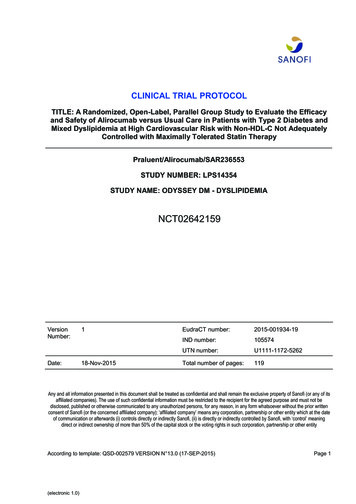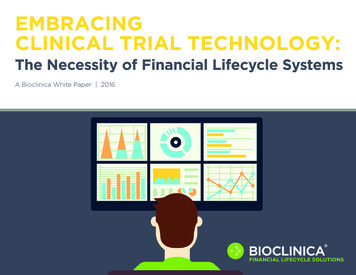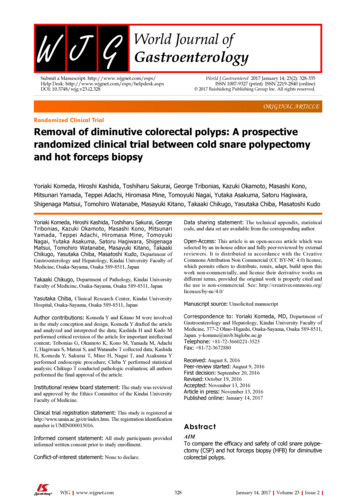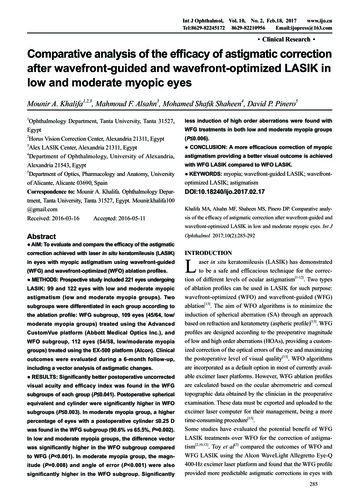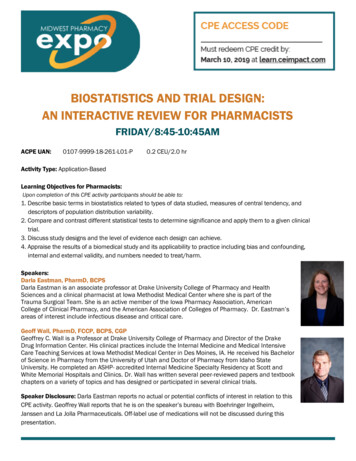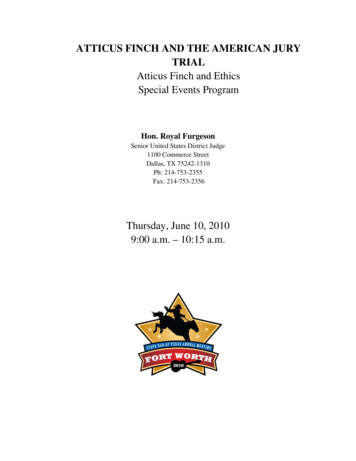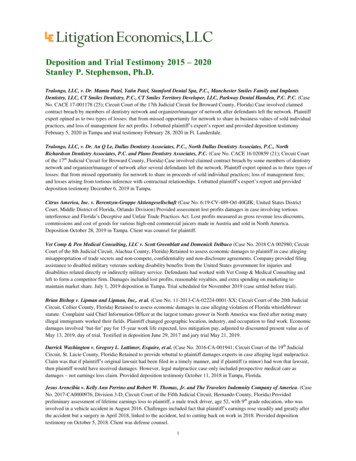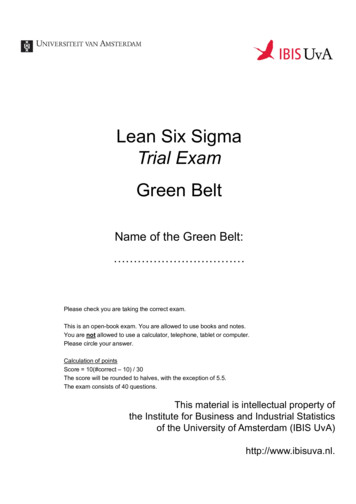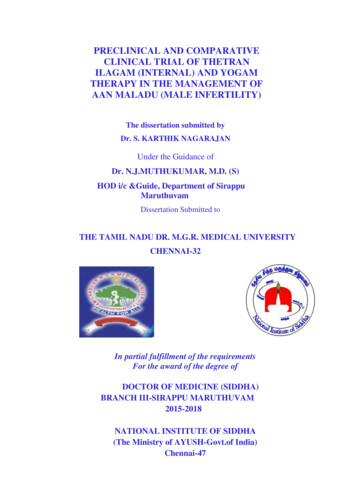
Transcription
PRECLINICAL AND COMPARATIVECLINICAL TRIAL OF THETRANILAGAM (INTERNAL) AND YOGAMTHERAPY IN THE MANAGEMENT OFAAN MALADU (MALE INFERTILITY)The dissertation submitted byDr. S. KARTHIK NAGARAJANUnder the Guidance ofDr. N.J.MUTHUKUMAR, M.D. (S)HOD i/c &Guide, Department of SirappuMaruthuvamDissertation Submitted toTHE TAMIL NADU DR. M.G.R. MEDICAL UNIVERSITYCHENNAI-32In partial fulfillment of the requirementsFor the award of the degree ofDOCTOR OF MEDICINE (SIDDHA)BRANCH III-SIRAPPU MARUTHUVAM2015-2018NATIONAL INSTITUTE OF SIDDHA(The Ministry of AYUSH-Govt.of India)Chennai-47
PRECLINICAL AND COMPARATIVECLINICAL TRIAL OF THETRAN ILAGAM(INTERNAL) AND YOGAM THERAPY INTHE MANAGEMENT OF AAN MALADU(MALE INFERTILITY)The dissertation submitted byDr.S.KARTHIK NAGARAJANUnder the Guidance ofDr. N.J.MUTHUKUMAR, M.D. (S)HOD i/c &Guide, Department of SirappuMaruthuvamDissertation Submitted toTHE TAMIL NADU DR. M.G.R. MEDICAL UNIVERSITYCHENNAI-32In partial fulfillment of the requirementsFor theaward of the degree ofDOCTOR OF MEDICINE (SIDDHA)BRANCH III-SIRAPPU MARUTHUVAM2015-2018NATIONAL INSTITUTE OF SIDDHA(The Ministry of AYUSH-Govt.of India)Chennai-47
DECLARATION BY THE CANDIDATEI hereby declare that this dissertation entitled “Preclinical and ComparativeClinical Trial of Siddha drug Thetran Ilagam (Internal) and Yogam therapy in theManagement of Aan Maladu (Male infertility) is a bonafide and genuine research workcarried out by me under the guidance of Dr.N.J.Muthukumar,M.D(s), AssociateProfesser & HOD (i/c), Department of Sirappu Maruthuvam, National Institute ofSiddha, Chennai -47, and the dissertation has not formed the basis for the award of anyDegree, Diploma, Fellowship or other similar title.Date:Signature of CanditatePlace:Dr.S.Karthik Nagarajan
BONAFIDE CERTIFICATECertified that I have gone through the dissertation submitted by Dr.S.KarthikNagarajan, (Reg.No: 321513202) a student of final year M.D(s), Branch-III,Departmentof Sirappu Maruthuvam, National Institute of Siddha, Tambaram Sanatorium,Chennai-47, and the dissertation work has been carried out by the individual only. Thisdissertation does not represent or reproduce the dissertation submitted and approvedearlier.Place: Chennai-47Date:Name and Signature of the Guide,Name and Signature of the HOD,Associate Professor&HOD (i/c)Department of Sirappu Maruthuvam,Department of SirappuMaruthuvam,National Institute of Siddha,National Institute of Siddha,Tambaram Sanatorium,Tambaram Sanatorium,Chennai-47.Chennai-47.Name and Signature of the DirectorNational Institute of SiddhaTambaram SanatoriumChennai-47
Acknowledgement
ACKNOWLEDGEMENTMy humble thanks to the Almighty God for giving me the opportunity do thisdissertation.I express my sincere thanks to respected Prof.V.BANUMATHI M.D(S),Director, National Institute of Siddha, Chennai edASSO.Prof.N.J.MUTHUKUMAR, M.D(S), and Head of the Department, ofSirappu Maruthuvam for his guideness, inspiration, unending patience, and hisencouragement throughout the course of my studies.I also extend my thanks to Dr.M.V.Mahalakshmi M.D(s) for their usefulsupport and constant encouragement during the course of thisstudy.I also extend my thanks to Dr.V.Mahadevan M.D(s) for their useful supportand constant encouragement during the course of thisstudy.I am very much happy to thank Dr.D.Periyasami. M.D(S), for her kindopinions in this dissertationwork.I am very much happy to thank Dr.P.Samundeeswari M.D(S), for her kindopinions in this dissertationwork.I express my cordial thanks to Asst.Prof. Dr.I.SangeethaM.D, ModernMedicine, National Institute of Siddha, Chennai, for his help during the study.I am very much happy to thank Dr.Petchiammal M.D.(S) Yoga Expert,National Institute of Siddha ,Chennai-47 for her kind opinions in this dissertationwork.I am very much happy to thank Miss.S.Nagalakshmi B.NAT., M.Sc (YogaTherapy) for her kind opinions in this dissertation work.I express my sincere thanks to Asst.Prof.Dr.V.Suba, Ph.D Dept.of,Pharmacology, for their excellent help study and other guidance to do the researchwork.I express my sincere thanks to Asst.Prof.Dr.Arvind M.D. (S)., M.Sc(HerbalBotany) for their excellent help in Drug Identification the research work.I express my sincere thanks to DrGayathri Natarajan.M.V.Sc.,Veterinarian
National Institute of Siddha for their excellent help in Animal Study.My special acknowledgements to Mr.M.Subramanian, M.Sc., (Statistics), SeniorResearch Officer, National Institute of Siddha, Chennai-47, for his valuable help instatistical analysis.I express my sincere thanks to Noble Research Solutions, Chennai.For theirexcellent help in Physiochemical Analysis and Histopathological studies.My special thanks goes to my father Mr.Subramanian, my motherMrs.S.Sangaragomathi, all my family members, my collegues and my belovedfriends for their encouragement and support in completing the dissertation.Last and most importantly, I am indebted to all my patients for willinglyaccepting themselves for this studyI also express my sincere thanks to all the teaching staffs of National Instituteof Siddha, Chennai.
CONTENTS
CONTENTSS. NoTITLEPAGE NO.1.INTRODUCTION12.AIM AND OBJECTIVE53.REVIEW OF LITERATURE7A) SIDDHA ASPECTS8B) MODERN ASPECTS30C) TRIAL DRUG624.MATERIALS AND METHODS765.RESULTS AND LYSIS138III.PHYSICO ISTICALANALYSIS182VII.CONSENTFORM185VIII. CASE SHEET PROFORMA10.BIBLIOGRAPHY188213
INTRODUCTION1
""[1]-INTRODUCTION:The siddha system of medicine is one of the ancient systems contemporaneouswith those of the submerged lands, Egyptian, Mesopotamian, Chinese and Grecianmedicines. The unique nature of this system is its continuous service to humanity formore than five thousand years[2].Tamil nadu the home of the siddhar was a vastcontinent several million of year ago[3]. "Siddhargal" or Siddhars were the premierscientists of ancient days. Siddhars, mainly from Southern India laid the foundation[4]for this system of medication. There were 18 important Siddhars in olden days andthey developed this system of medicine. Hence, it is called Siddha medicine. Theword Siddha comes from the word Siddhi which means an object to be attainedperfection or heavenly bliss[5].Siddha medicine means medicine that is perfect. Siddha medicine is claimedto revitalize and rejuvenate dysfunctional organs that cause the disease and tomaintain the ratio of mukkutram Vaatham, Pitham and Kabam. According to theSiddha medicine, various psychological and physiological functions of the body areattributed to the combination of sevenelements: First is saaram (plasma) responsible for growth, development andnourishment; Second is senneer(blood)responsible for nourishing muscles,imparting color and improvingintellect; The third is oon(muscle) responsible for shape of thebody; Fourth is kozhuppu (fatty tissue) responsible for oil balance andlubricatingjoints;2
Fifth is elumbu (bone) responsible for body structure and posture andmovement; Sixth is moolai (bone marrow) responsible for formation of bloodcorpuscles; And the last is sukkilam/suronitham (sperm/ova) responsible forreproductionIt is assumed that when the normal equilibrium of the three humors (Vadham,Pitham and Kabam) is disturbed, disease is caused. The factors, which assumed toaffect this equilibrium, are environment, climatic conditions, diet, physical activities,and stress. Under normal conditions, the ratio between these three humors i.e.:(Vadham, Pitham, Kabam) 1:1/2: ¼ respectively [6].The siddha medicine given to Herbal products, Inorganic substance andAnimal products (thavara, thathu, sangama things).The drugs used in siddha medicinewere classified on the basis of five properties Suvai (taste), Gunam(character), Veeryam(potency), Pirivu(class) And Mahimai(action).According to their mode of application, the siddha medicines could becategorized into two classes [6]: Internal medicine was used through the oral route and further classified into32 categories based on their form, methods of preparation, shelf-life,etc. External medicine includes certain forms of drugs and also certain applications(such as nasal, eye and ear drops), and also certain procedures (suchas leech application). It also classified into 32 categories. According to the siddha medicine system, diet and lifestyle play a major role,not only in health but also in curing diseases. This concept of the siddha medicine istermed as pathiyam and apathiyam, which is essentially a list of "do's and don'ts"[7].3
The art of living depends upon several factors including maintenance ofheredity with healthy progeny. Healthy progeny depends upon healthy gametes fromboth male and female partners of conjugated life style.Infertility bears a social stigma. According to The World Health ffect8to12percentofworldwide[9][10].couplesIt means failure of a couple to become parent after one year ofsuccessful married life. Male infertility is commonly due to deficiencies in the semen,and semen quality is used as a surrogate measure of malefecundity.[11]Male infertility is a vexing clinical problem. The incidence of male infertility varies indifferent region. The incidence of infertility among males 40%, females 40%, bothsex 20%[12].To Generate new knowledge on Siddha Andrology to fertility regulation andEndocrine disorders ancient Siddha literatures describes many safe and effectivedrugs identified by Siddhars for thousands of oolarYogam(Asanams)Asanam(Yogam) one of the Astaanga yogam .Yogasanam to fight all theemotional and psychological traumas by proving a calm and peaceful state of health,which ultimately boosts well-functioning of reproductive system.A quiet,stable mind and body promotes fertility.There are certain yogasanam thatespecially target the reproductive organs and the pelvic area.Men are subject to infertility problems like low sperm count ,which is quiet oftenrelated to high stress levels.Regular Yogam practice helps release stress and mostimportantly yoga can help regain sexual stamina.So I am eager to conduct asuccessful clinical study in THETRAN ILAGAM (INTERNAL) and YOGAMTHERAPY for Aanmaladu (Male infertility)4
AIMOBJECTIVE5
AIM & OBJECTIVEAIM: To evaluate the therapeutic efficacy of Thetran Ilagam and Yogamtherapy in the Aan maladu (Male infertility) .OBJECTIVE: To evaluate the therapeutic efficacy of Thetran Ilagamin Aan maladu(Male infertility) to increase the sperm concentration, viscosity ofsemen and to reduce premature ejaculation, nocturnal emission inAANMALADU. To evaluate the safety profile of the trial drug Thetran Ilagan To collect the authorized measures and review the ideas of Aan maladuin Siddha and modernliteratures. To have an idea about the relation of the disease with age, habits,occupation, economic states, family history and climaticconditions. To expose the efficacy of siddhars diagnostic principles such asmukkutram, envagai thervugal, eazhu udalthadhukkal, neerkuri andneikkuri. To have detailed clinicalinvestigations. To have a clinical trial on the disease “AAN MALADU” with thesiddha herbal formulation of “THETRAN ILAGAM”. Toevaluate the,Toxicity study [acute & sub-chronic]Sexual Health ScoreYogam therapy Bio –statistical analysisTo handle the modern parameters to confirm the diagnosis andprognosis of thestudy.6
REVIEWOFLITERATURE7
SIDDHA ASPECT8
REVIEW OF LITERATURESIDDHA ASPECTFORMATION OF FETUS COMBINES WITH PANJABOOTHAM:[13]The ovum consists of the element earth, whereas the sperm consists of fire andair, the uterine wall nourishes it has water and uterine cavity is one of the element ofspace. Therefore in the formation of fetus all the five elements combine and create it.DETERMINATION OF GENDER OF EMBRYO:9
At the time of copulation if the male dominates then it is male, if the femaledominates then it is female, if the male and the female are equal then the child wasintersex gender or an eunuch.THE ROLE OF VAAYUS IN FERTILIZATION:Abanan stays outside the zygote and protect it. The pranan goes along withspermatozoa and bisects the size of the zygote [14][17] .REASON FOR MALADU IN SIDDHA LITERATURE:10
[19]According to agathiyar uyar gnanam, at the time of copulation the following11 principle‟ s (the five organs of action, the five organs of perception, and soul) tobeconcentrated by both thepartners[14].In these forces may act in an abnormal manner and cause diseases thereby.Similarly, in the great organisms of the cosmos, they may act abnormally likewise andbring about diseases on earth and its atmospheric conditions such as earthquakes,storms, lightning, and rain-falls resulting in floods or inundations and so on. Again,the quality of life found in the elements constituting the blood of man corresponds tothe quality of the invisible influences radiating from mars. If the soul- essentials thatcharacterize the influences of Venus do not exist, the natural instincts that causemen and animals to propagate their species would cease to operate; because allbeings in the universe are sympathetically connected with the only one universalprinciple of life from Venus resulting in love between two people of theoppositesex[20][21].11
AAN MALADU[22][23]SUKKILA VATHAM:[24]Emaciation, constipation, oliguria, bleeding from the nose, phlegmaccumulation due to increased kapham, breathlessness, loss of taste. All the symptomsare associated with affected sukkilam, according to yugi[25].AAN MALADU:According to T.V.Sambasivam pillai dictionary, The semen in such cause wasdevoid of sweetness and life and float on the surface of water. The urine
(Asanams)Asanam(Yogam) one of the Astaanga yogam .Yogasanam to fight all the emotional and psychological traumas by proving a calm and peaceful state of health ,which ultimately boosts well-functioning of reproductive system. A quiet,stable mind and body promotes fertility.There are certain yogasanam that
